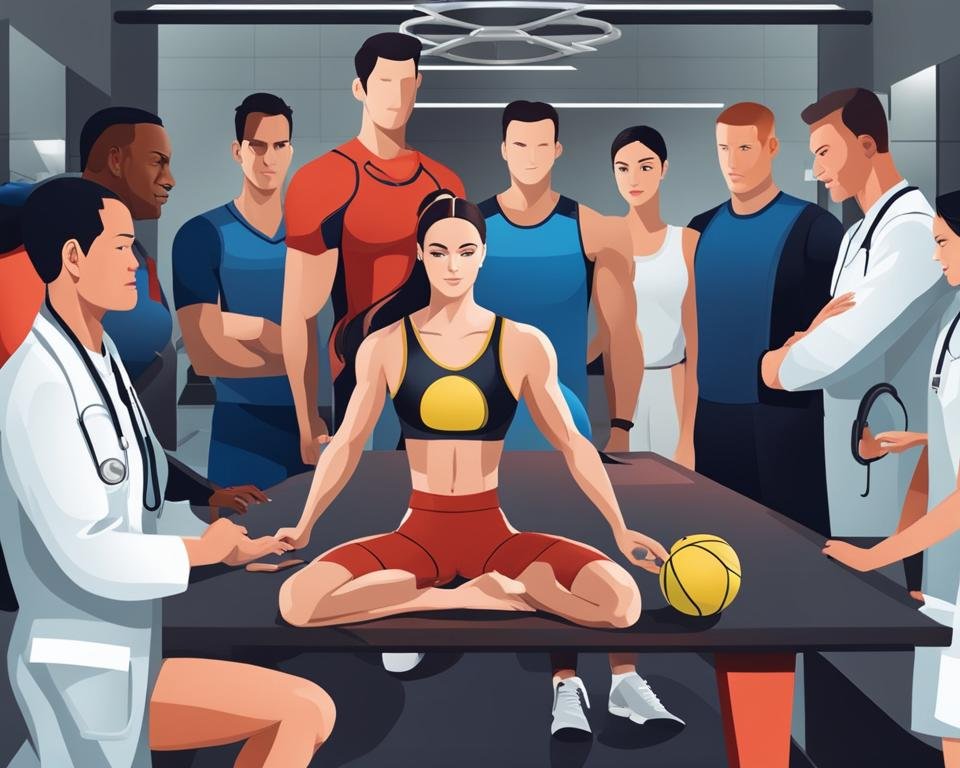The field of sports medicine has undergone a significant transformation over the years, shifting its focus from recovery to prevention. While sports medicine previously focused on treating injuries and rehabilitating athletes, it now emphasizes the importance of preventing sports-related injuries altogether. This proactive approach has revolutionized the way athletes are cared for, ensuring their long-term health and well-being.
In this article, we will explore the historical roots of sports medicine, the multidisciplinary approach in the field, the psychological aspects of sports medicine and injury prevention, the transition to proactive health strategies, evolving sports medicine techniques, the importance of injury prevention exercises, emerging careers in sports medicine, case studies on sports injury prevention programs, and the future trajectory of sports medicine and injury mitigation.
Key Takeaways:
- Sports medicine has evolved from a focus on recovery to a proactive approach emphasizing injury prevention.
- A multidisciplinary approach in sports medicine involves collaboration between various professionals.
- The psychological aspect of sports medicine and the prevention of mental impacts in athletes is gaining recognition.
- Proactive sports health strategies aim to identify and address potential issues before they become injuries.
- The field of sports medicine is continually evolving with advanced techniques and specialized training.
The Birth of Sports Medicine and Injury Prevention
Sports medicine, as we know it today, has ancient roots that can be traced back to the time of the Ancient Olympics. In those times, treating injuries sustained by athletes during the Olympics was of utmost importance. This laid the foundation for the development of sports medicine as a specialized branch of medicine.
Heading 3: The historical roots: From Ancient Olympics to modern times
Ancient Greece holds a significant place in the history of sports medicine. The Ancient Olympics, which began in 776 BC, were not only an event of sporting excellence but also a platform where athletes received medical attention. The Greeks recognized the value of providing the best possible care for their athletes and developed techniques to treat and prevent injuries.
The Ancient Greeks believed in the concept of “soma,” which emphasized the connectedness of the mind, body, and spirit. This holistic approach to health and well-being laid the groundwork for the philosophy behind sports medicine. They understood the importance of maintaining a balance between physical fitness, mental resilience, and social well-being.
Heading 3: Herodicus to Bernardino Ramazzini: Pioneers in sports health
Throughout history, numerous pioneers have contributed to the development of sports medicine. One such figure is Herodicus, a Greek physician from the fifth century BC. Herodicus was known for his therapeutic exercises, which he developed specifically for Olympiads. These exercises aimed to promote physical strength, flexibility, and injury prevention.
Another significant figure in the history of sports medicine is Bernardino Ramazzini, an Italian physician who lived in the 17th century. Ramazzini devoted much of his career to studying the relationship between movement and health, particularly in workers. His work highlighted the importance of physical activity, proper ergonomics, and injury prevention in maintaining overall well-being.
These early pioneers paved the way for the modern field of sports medicine and injury prevention. Their contributions laid the foundation for the development of specialized techniques, the establishment of sports medicine clinics, and the recognition of the importance of holistic care for athletes.
| Pioneer | Contribution |
|---|---|
| Herodicus | Development of therapeutic exercises for Olympiads |
| Bernardino Ramazzini | Study of the relationship between movement and health |
Expanding the Boundaries: Multidisciplinary Approach in Sports Medicine
The field of sports medicine has evolved to embrace a multidisciplinary approach, where professionals from various domains collaborate to deliver comprehensive care to athletes. This approach recognizes that sports injuries and performance optimization involve not only physical aspects but also psychological and sociological factors. By leveraging the expertise of sports medicine professionals such as physiotherapists, nutritionists, psychologists, strength and conditioning coaches, sports therapists, biomechanists, and sports massage therapists, athletes receive holistic treatment plans tailored to their specific needs.
The collaborative efforts of multidisciplinary teams in sports medicine allow for a multifaceted assessment and treatment approach. Physiotherapists provide specialized rehabilitation exercises and techniques to promote tissue healing and functional recovery. Nutritionists ensure optimal dietary practices to support athletes’ performance and enhance injury prevention. Psychologists address the psychological impacts of sports injuries, helping athletes develop mental resilience and cope with the emotional challenges of recovery. Strength and conditioning coaches design training programs to improve athletes’ physical fitness and prevent future injuries. Sports therapists and biomechanists analyze movement patterns and biomechanical factors to identify potential areas of vulnerability and develop strategies to optimize performance while minimizing injury risk.
By leveraging the diverse knowledge and skills of multidisciplinary sports medicine professionals, athletes receive comprehensive care that takes into account the intricate interplay of physical, psychological, and sociological factors. The multidisciplinary approach in sports medicine expands the boundaries of traditional treatment methods, contributing to improved athlete outcomes and overall sports performance.

Sports Medicine and Injury Prevention Laid on Psychological Grounds
The field of sports medicine acknowledges the significant impact of psychological factors on athletes’ well-being and performance. Athletes not only face physical challenges but also experience psychological impacts when dealing with sports-related injuries. These psychological aspects, including emotions like anger, frustration, depression, and anxiety, can hinder an athlete’s recovery and overall mental health.
Tackling the Psychological Impacts of Athletic Injuries
Recognizing the importance of mental well-being in sports medicine, professionals now address the psychological impacts of athletic injuries with specialized care. By providing support and guidance, sports medicine experts help athletes navigate the emotional challenges that arise as a result of their injuries. This holistic approach considers the psychological aspects of injury alongside the physical recovery, promoting overall healing and mental resilience.
The Rise of Sports Psychology within Injury Rehab Programs
To effectively address the psychological impacts of athletic injuries, sports medicine professionals have integrated sports psychology techniques into injury rehabilitation programs. These techniques aim to enhance athletes’ mental resilience, promote positive mindset, and develop coping strategies to overcome the emotional obstacles associated with the recovery process. By applying sports psychology principles, professionals help athletes build mental strength, ultimately contributing to their successful return to sports.
| Benefits of psychological support in injury rehab programs | Enhanced athlete well-being | Accelerated recovery process | Improved athlete performance |
|---|---|---|---|
| Promotes mental resilience | Helps athletes manage stress and anxiety | Supports adherence to rehabilitation protocols | Boosts self-confidence and motivation |
| Reduces the risk of re-injury | Fosters a positive mindset | Facilitates effective communication with healthcare professionals | Aids in setting realistic goals |
| Empowers athletes to cope with setbacks | Addresses emotional challenges during recovery | Enhances overall mental well-being | Encourages a balanced approach to sports |
The Transition from Reactive to Proactive Sports Health Strategies
The field of sports medicine has undergone a significant shift from a reactive approach to a proactive one. Rather than solely focusing on recovery and treatment after an injury has occurred, sports medicine professionals now prioritize preventive measures to minimize the risk of injuries and optimize athlete performance.
This proactive approach in sports medicine involves the implementation of preventive measures aimed at identifying potential issues before they develop into injuries. By utilizing advanced assessment tools and techniques, sports medicine professionals can identify risk factors and tailor individualized strategies to address them.
Preventive measures in sports medicine encompass a range of interventions, including:
- Comprehensive athlete evaluations to assess overall health and identify potential risk factors
- Development of personalized training programs that emphasize injury prevention
- Implementing proper warm-up and cool-down routines
- Integrating strength and conditioning exercises to build resilience and improve overall performance
- Utilizing biomechanical analysis to identify faulty movement patterns that may contribute to injury
By adopting a proactive approach, sports medicine professionals can optimize athlete performance while minimizing injury risk. Through preventive measures and personalized care, athletes can stay healthy, perform at their best, and achieve long-term success in their chosen sport.

Sports Medicine Techniques: Transforming Athlete Care
A glance at evolving treatment methods: from Kinesiology tape to Shockwave therapy
The field of sports medicine has witnessed remarkable advancements in treatment techniques, revolutionizing the way athlete care is delivered. One such innovation is the use of Kinesiology tape, which has gained popularity for its versatile applications in muscle support and injury prevention. By providing structural support and enhancing blood flow, Kinesiology tape helps athletes improve their performance and reduce the risk of injuries. Additionally, Shockwave therapy has proven to be highly effective in accelerating tissue healing, particularly for conditions such as tendinitis and fasciitis. This non-invasive treatment delivers high-intensity sound waves to stimulate the body’s natural healing response, resulting in faster recovery and reduced pain.
Continual education and specialized training for sports medicine professionals
Keeping pace with evolving treatment methods in sports medicine requires sports medicine professionals to undergo continual education and specialized training. By staying up-to-date on the latest advancements and research in the field, these professionals can provide the highest level of care to athletes. Additionally, specialized training equips them with the necessary skills and expertise to effectively implement advanced sports medicine techniques. This ongoing education and training ensure that sports medicine professionals are well-equipped to address the unique needs of athletes and contribute to their optimal performance and well-being.
| Treatment Method | Application | Benefits |
|---|---|---|
| Kinesiology Tape | Muscle support, injury prevention | Enhanced performance, reduced risk of injuries |
| Shockwave Therapy | Tissue healing | Faster recovery, reduced pain |
Preventing Sports-Related Injuries Through Evolving Understanding
Preventing sports-related injuries is a fundamental aspect of sports medicine. Over time, there has been an evolving understanding of sports injuries, empowering sports medicine professionals to recognize and address the common types of injuries that athletes frequently encounter. By implementing preventive sports therapy techniques, such as strength training and biomechanics analyses, the risk of injuries can be minimized, while optimizing athletic performance.
Recognizing and addressing the common types of sports injuries
An essential component of injury prevention is the ability to identify and address the common types of sports injuries that athletes may experience. Through comprehensive assessments and diagnostic tools, sports medicine professionals can evaluate risk factors and detect early signs of potential injuries. By understanding the specific characteristics and mechanisms of these injuries, tailored preventive strategies can be developed to mitigate the risk and promote long-term athlete well-being.
Preventive sports therapy: From strength training to biomechanics analyses
Preventive sports therapy encompasses a range of techniques aimed at reducing the likelihood of sports-related injuries. One crucial approach is strength training, which focuses on developing the muscular strength, endurance, and stability necessary to withstand the demands of various sports activities. By implementing targeted strength training programs, athletes can enhance their overall physical condition, thereby minimizing the risk of injuries.
Additionally, biomechanics analyses play a vital role in injury prevention. By evaluating the movements and mechanics involved in different sports activities, sports medicine professionals can identify potential areas of vulnerability or inefficiency. These insights allow for tailored corrective exercises and modifications to correct movement patterns, optimize performance, and prevent injuries.

Adapting to New Challenges in Athletic Health and Wellness
The field of sports medicine continuously adapts to meet the new challenges in athletic health and wellness that arise as athletes push the boundaries of physical capabilities. Sports medicine professionals play a vital role in addressing the evolving needs of athletes by staying updated on the latest research and techniques. This enables them to effectively manage new types of injuries, develop innovative treatment methods, and promote the overall well-being of athletes.
With the ever-changing landscape of sports and the increasing demands placed on athletes, it is crucial for sports medicine professionals to adapt their practices to ensure optimum athlete care. This includes implementing advanced diagnostic tools, employing cutting-edge therapies, and embracing interdisciplinary collaboration to deliver comprehensive health solutions.
One of the key challenges in sports medicine is the prevention and management of sports-related injuries. As athletes engage in high-intensity training and competitions, the risk of injuries becomes more pronounced. Sports medicine professionals must constantly explore new injury prevention techniques, design tailored training programs, and educate athletes on proper injury prevention strategies.
Furthermore, addressing the evolving needs of athletes necessitates a holistic approach to their health and wellness. Sports medicine professionals not only focus on treating physical injuries but also address the mental, emotional, and nutritional aspects of athletes’ well-being. By considering the whole athlete, professionals can facilitate optimal performance, expedite recovery, and support long-term athletic success.

In conclusion, the field of sports medicine is constantly evolving to adapt to new challenges in athletic health and wellness. By staying at the forefront of research and innovation, sports medicine professionals can effectively address the evolving needs of athletes in a holistic and comprehensive manner, ensuring their well-being and enabling them to perform at their best.
Injury Prevention Exercises and Their Role in Athletic Longevity
Injury prevention exercises play a critical role in ensuring athletic longevity. Athletes face the constant challenge of enduring the rigors of sports while minimizing the risk of injuries. To overcome this challenge, conditioning techniques are implemented to enhance an athlete’s physical endurance and stamina, allowing them to perform at their best for longer periods.
Conditioning exercises typically involve a combination of cardiovascular workouts, plyometric exercises, and agility drills. These activities aim to improve an athlete’s cardiovascular fitness, explosive power, speed, agility, and overall physical fitness. By engaging in regular conditioning exercises, athletes can enhance their endurance, reduce fatigue, and lower the risk of injuries resulting from fatigue-induced mistakes.
Strengthening regimens also play a crucial role in shielding athletes against future injuries. Through targeted strength training exercises, athletes can build strong muscles, tendons, and ligaments that are better able to withstand the demands of their sport. These exercises often target specific areas of the body that are prone to injury, such as the core, lower back, knees, and ankles.
An effective strengthening regimen typically includes a variety of exercises such as weightlifting, resistance training, and bodyweight exercises. These exercises help athletes develop muscular strength, power, and stability, reducing the risk of muscle imbalances and providing a solid foundation for overall athletic performance.
By incorporating injury prevention exercises into their training routines, athletes can significantly reduce the risk of future injuries and extend their athletic longevity. The combination of conditioning techniques and strengthening regimens allows athletes to perform at their peak while minimizing the risk of injuries, ultimately promoting their overall health and well-being.
Emerging Careers in Sports Medicine: An Overview
The field of sports medicine offers a wide range of emerging career opportunities. With the proliferation of sports medicine degrees and specialized training programs, individuals can pursue various career paths within the field. Whether you have a passion for treating athletes’ injuries, conducting research, or exploring the intersection of technology and sports care, there is a growing demand for professionals in this dynamic and evolving field.
The Proliferation of Sports Medicine Degrees and Career Paths
Sports medicine degrees have gained popularity as more individuals recognize the importance of preventative and proactive healthcare for athletes. These degrees provide comprehensive training in areas such as injury prevention, diagnosis, treatment, rehabilitation, and performance optimization.
With a sports medicine degree, you can pursue diverse career paths, including:
- Athletic Trainer: Work directly with athletes to prevent, diagnose, and treat injuries.
- Sports Physician: Specialize in diagnosing and treating sports-related injuries and conditions.
- Physical Therapist: Assist in the rehabilitation and recovery of athletes.
- Strength and Conditioning Specialist: Develop training programs to enhance athletes’ physical performance and reduce the risk of injuries.
These are just a few examples of the many career paths available in sports medicine. Depending on your interests and skills, you can find a role that aligns with your passion and expertise.
The Intersection of Technology, Research, and Sports Care Professions
In today’s digital age, technology plays a significant role in sports medicine. Advancements in imaging, wearable devices, data analytics, and telemedicine have transformed the way athletes are assessed, treated, and monitored.
Professionals in sports care are utilizing technology to:
- Track athletes’ performance and recovery through wearable devices and data analysis.
- Use virtual reality for rehabilitation and performance enhancement.
- Implement telemedicine to provide remote consultations and monitoring.
Additionally, research plays a vital role in advancing the field of sports medicine. Researchers are continuously exploring new treatment modalities, injury prevention strategies, and performance optimization techniques. Sports medicine professionals who stay updated with the latest research findings can provide evidence-based care and contribute to the field’s growth.
Sports Injury Prevention Programs: Case Studies and Success Rates
Sports injury prevention programs have become an essential component of athlete care, aimed at reducing the incidence of injuries and optimizing performance. To evaluate the effectiveness of these prevention strategies, case studies have been conducted to analyze their success rates. These case studies provide valuable insights into the efficacy of different approaches to sports injury prevention and inform evidence-based practices in athlete training routines.
By examining real-life scenarios and outcomes, case studies shed light on the impact of preventive measures in various sports and levels of competition. They allow sports medicine professionals to gain a deeper understanding of the factors that contribute to injury prevention success and identify best practices.
Moreover, the analysis of success rates in sports injury prevention programs helps in determining the effectiveness of different strategies and interventions. It provides a quantitative measure of the outcomes achieved through these programs and establishes a benchmark for evaluating their impact.
Incorporating evidence-based practices into athlete training routines is crucial for ensuring optimal performance and minimizing the risk of injuries. By aligning training methods with scientifically proven principles, sports medicine professionals can maximize the benefits of preventive measures and enhance overall athlete well-being.
As the field of sports medicine continues to evolve, case studies and success rates of sports injury prevention programs play a vital role in shaping and refining the approach to injury prevention. By leveraging these valuable insights and evidence-based practices, sports medicine professionals can design more effective and tailored prevention strategies, leading to better athlete care and improved performance.
Conclusion
Sports medicine is a dynamic field that continues to evolve in response to new research findings, advancements in technology, and a deeper understanding of athlete needs. The future of sports medicine holds great promise as it seeks to further enhance injury mitigation techniques and optimize athlete recovery and performance.
By consolidating recovery and prevention strategies, sports medicine professionals play a crucial role in ensuring the ongoing success of athletes at all levels. This comprehensive approach recognizes that preventive care is just as important as treating injuries. By adopting this holistic perspective, sports medicine can provide athletes with the tools and support they need to achieve their full potential.
Looking ahead, the future trajectory of sports medicine will involve harnessing the power of cutting-edge technologies, such as wearable devices and data analytics, to monitor and assess athletes’ health in real-time. This proactive approach will enable sports medicine professionals to identify potential risks and intervene before injuries occur, ultimately maximizing athlete performance and well-being.
As the field of sports medicine continues to evolve, it is clear that the integration of recovery and prevention strategies is key to promoting long-term athlete success. By staying at the forefront of research, embracing innovation, and prioritizing the holistic well-being of athletes, sports medicine professionals will continue to elevate the standard of care and make significant contributions to the field.
FAQ
What are the historical roots of sports medicine?
How does the multidisciplinary approach work in sports medicine?
What is the role of psychology in sports medicine and injury prevention?
How has sports medicine transitioned to a proactive approach?
How have sports medicine techniques evolved over time?
How do injury prevention exercises play a role in sports medicine?
What are the emerging careers in sports medicine?
Are there any case studies on sports injury prevention programs?
What can we expect from the future of sports medicine?
Source Links
- https://www.open.edu/openlearn/health-sports-psychology/sport-fitness/the-evolution-sports-medicine-over-the-last-50-years-the-wet-sponge-holistic-care
- https://seaver.pepperdine.edu/blog/posts/understanding-sports-medicine-a-comprehensive-guide.htm
- https://www.northeastspineandsports.com/blog/the-history-of-sports-medicine/
